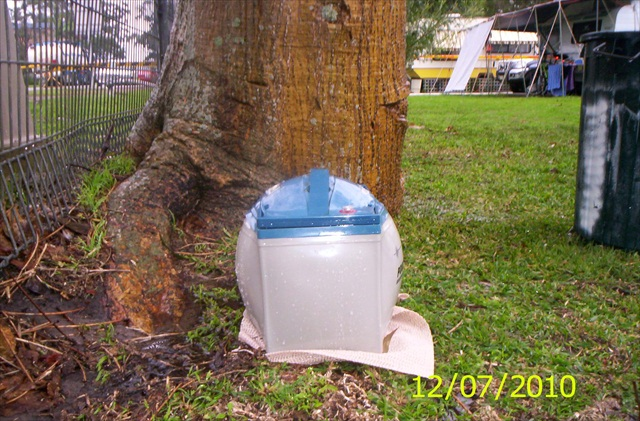Here's Scott:
David Gill, new owner of Tondelayo and new member here ran into an interesting situation that is relevant to us here. As a matter of fact I have 6 AGM batterys on Valkyr. I like them because you can’t spill acid out of them. I have had bad problems on a prior boat with that.
However the description here and the photos David provided are very sobering. I have had 3 AGM batteries in the past that have swollen in a very limited way and went bad. We had them replaced. I have had this happen to a couple of west marines SeaVolt AGM group 27 and 31 batteries as well as one of the optima blue top spiral AGM batteries just in the last month. So this is a very reasonable heads up. Thank you David for writing this up, and submitting it with the pictures.
Hi Scott.
Here’s a bit of information that may be relevant to anyone using Sealed 12v batteries. I don’t use them on Tondelayo but anyone who does wouldn’t want this to happen while at sea.
At 0848 hrs on 12 July 2010, pumper 402 Nelson Bay attended a caravan park in Nelson Bay. On arrival they found a 12V sealed caravan battery (also called Valve Regulated Lead Acid or VRLA battery) with its sides and top markedly bulging.

Park staff had removed the battery from inside a caravan to a grassed area.
The BA team was to cool the battery with spray from a line of 38 mm hose from behind substantial cover. However, the battery slowly continued to expand. Temperature readings taken with a TIC registered 49 ºC.
As it appeared the battery could explode, a hot zone of 30 m and a 50 m exclusion zone were established. A second pumper and hazmat were called to assist.
Accessing the internet from 260 Hazmat’s laptop, a VRLA battery distributor was contacted. They advised to cool with water for the next 24 hours and then disposed of at a regular council battery collection point.
Sustained cooling from substantial cover eventually reduced the battery’s temperature to 26 ºC. After being deemed safe, it was immersed in water and placed in an isolated area of the council waste disposal facility at Port Stephens. The battery’s condition was monitored by council staff and the NSWFB was contacted when the casing broke open two weeks later.
Concerned about the impact that a battery explosion would have in the confined living area of a caravan, SO Kwan submitted an observation to the Lessons Learned Centre. We found that:
At the Nelson Bay caravan park, it appears that either the relief valve failed or the heat and gas generated during charging exceeded the valve's capacity. The plastic case softened with the increased temperature and the higher pressure inside caused it to expand. As it cooled, the plastic case became hard and brittle, and eventually broke.
- VRLA batteries are used in a variety of applications. Different types can deliver short duration – high energy output (for starting combustion engines) or release energy more slowly (as power supply backup for telecommunications equipment, etc).
- They do not need topping up with water. Oxygen evolved at the positive plates recombines with the hydrogen ready to evolve on the negative plates, creating water and preventing water loss.
- Several conditions can cause the battery to heat up, such as high ambient temperature, poor ventilation, incompatible charging equipment, charger malfunction and battery cell failure.
- Generally, gas is not produced during charging. However, if a battery is overcharged due to charger malfunction or battery failure, gas pressure can build within the battery. A pressure relief valve is designed to release the excess hydrogen and oxygen.
Firefighters are asked to contact FIRU if they encounter expanded VRLA batteries. This will help to research the frequency of this and whether there is a problem with charging units or the batteries themselves.
Regards,
Dave Gill
Mobile: 0488 285 286
Email: davegill@southernphone.com.au
PDF Download
Sobering. I wonder if our Australian readers can shed any additional light on this incident?













No comments:
Post a Comment